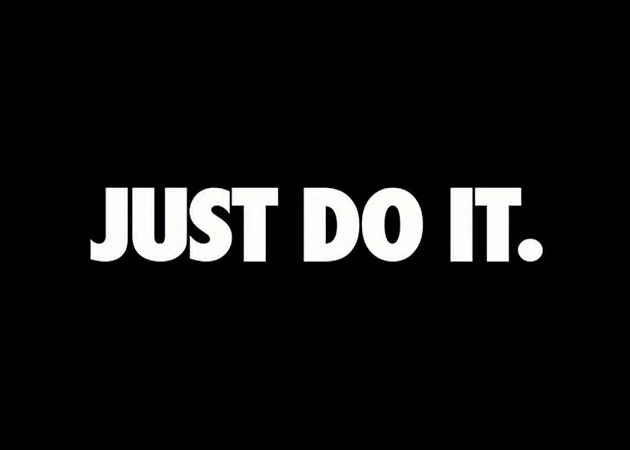Just Do It
A Call To Action And Getting Started
"Just Do It" has been popularised by Nike who have had it as a trademark since 1988 and like all successful promotional ideas it is one of those phrases that can mean whatever you want it to mean.
Routine Task vs. New Challenge
In my experience there is a big difference between a call to action which involves (a) getting started with a routine task or activity and (b) taking on a new challenge, sorting out a problem and creating a solution from scratch.
With a routine task or activity that you have done many times before the call to action is about overcoming your innate inertia and resistance to just doing what you know you should do.
Whereas the call to action with a new challenge and creating a solution from scratch requires you to have a process for getting started.
How To Just Do it With A Routine Task

I have found that the most effective way of consistently doing routine tasks is to:
[1] Remove as many obstacles as possible that will delay you getting started.
I have recently started going to the gym again to improve my core upper body strength and to improve my physical flexibility. I know from past experience that the more obstacles I can remove to my actually getting off my backside and down to the gym the easier it is to just do it 5 or 6 times per week.
So I wear my tracksuit and gym kit to the gym to reduce the amount of preparation and time spent/wasted on changing my clothes. Similarly I do not shower at the gym but at home as and when I would normally have my daily shower.
I also go to the gym as my first task each morning and thus at the beginning of my day and before I get immersed in the activities of my work and personal projects. This also has the benefit that there are less people in the gym and so I do not get delayed in getting in and out of the gym or in waiting to use equipment within the gym.
[2] Reach a level of agreement within yourself as to what constitutes a satisfactory or adequate result.
Little and Often vs. the Big Effort
I used to get myself in all sorts of trouble by allowing my gym session to become too long. These days I have learned that there is a minimum number of exercises and weight lifting routines that will deliver the maximum benefit. So whereas I used to find that my sessions gradually expanded to about 90 minutes now I limit myself to a maximum of 30 minutes per gym visit.
I have found that the "little and often" approach makes it far easier for me to drag myself down to the gym, plus it interferes far less with my day than maximising my gym visits with the full range of exercises and routines each visit.
With the little and often approach I really do make it very easy for myself to go the gym often and I really do. Whereas, in the past, when I tried to maximise my visits and took 90 mins over it, this increasingly became an obstacle to me going because it became such a big event and thus a big deal and this gave my inertia and laziness more "good reasons" not to go.
Satisficing vs. Optimisation
Satisficing is a heuristic - a practical shortcut - for making decisions that aims for a satisfactory or adequate result, rather than the optimal solution.
I am not a professional athlete and I am not training for any event. I am simply working at staying reasonable fit and healthy for a man in his sixties.
I have worked out what constitutes a satisfactory result for me and I have reached an agreement within myself that I can commit to and just do it 6 days a week.
[3] Commit to forming the right habits to achieve a deferred but far larger benefit.
In Atomic Habits James Clear explains how small and seemingly insignificant changes will compound into remarkable results if you persist with them consistently over many years.
I know that this is certainly very true when it comes to my physical health, well being and overall longevity.
James Clear advises a 2 step approach to creating and reinforcing new habits, and which I applied to rejoining a local gym.
Start Very Small
When you start on the path of creating a new habit, create a "launch
habit" that is almost ridiculously simple and small, so small you won't
say no because it would seem ridiculous not to do it.
At the starting out stage, doing the habit is what matters and it is far more important than how much you do.
For examples, a few years ago I wanted to go the gym regularly so I set myself the task of just turning up at the gym for 10 mins several times a week. Then I would leave.
After a couple of weeks of this, the
habit of going to the gym was starting to get established. I increased
the duration of the visit to 15 mins and continued like that for another
couple of weeks by which time the habit was stronger and then I
increased the duration to 30 mins per visit.
Set Up A "Gateway Habit" with "The 2 Minute Rule"
In "How to Stop Procrastinating With the “2-Minute Rule” James Clear says:
"When you start a new habit, it should take less than two minutes to do. You’ll find that nearly any habit can be scaled down into a two-minute version"
My gateway habit to getting myself out of the door every morning to go the gym is that as soon as I get out of bed and into my gym kit I go into the kitchen and make myself a cup of my favourite Vietnamese coffee. I place my car keys on the table besides my coffee cup. As soon as I have finished the coffee I pick up the keys, stand up and head for the door.
How To Just Do it With A New Challenge

[1] The Balance of Preparation vs. Committed Engagement
I used to work for an IT program director who used to say to his management team:
"I want you to deliver a solution and not a plan for a plan!"
This became a running joke amongst the team but we took it seriously because we knew that what he wanted, and needed, was results.
The rationale behind his aphorism was that all to often in his experience IT contractors either did not know how to start delivering a solution or if they did, they didn't have the cajones to own it and took shelter in a group effort to create a plan for a plan!
You need to have a simple process for getting started. It doesn't have to be an end-to-end map but just some basic method for getting started.
By all means do your homework and get briefed - this is important - but then move into action as soon as practically possible. To coin a phrase: just do it!
[2] When you can't see where you are going - narrow your present focus down to the one next step you must take to progress you towards a solution.
The human brain likes shortcuts [heuristics] which are predefined processes for how to handle situations as they arise.
You use these shortcuts all the time. Every action that you take is a predefined process that you have either been taught or that you have worked out for yourself. Making a cup of coffee, using your laptop or smartphone, opening a door, greeting someone, the list is endless and encompasses every area of life.
If you don't have a process for dealing with new challenges you will likely go round in circles and it will burns mental energy and can cause mental blocks.
Can you imagine NOT knowing how to make a cup of coffee or how to greet people and say hello or engage in a social conversation?
The key thing is that you have some process in place for engaging with new challenges.
For many years I worked as a business consultant and senior interim manager/trouble shooter. Clients were rarely interested in the consultancy report, the only deliverable that mattered was results.
The start point for getting things done was to understand what was going on, what was going wrong and to figure out very early on what needed to change to get the desired results.
My start point was always to start talking informally to as many people as possible and ask them many questions. The focus of my questions was usually to get them talking about themselves and what they do and to get them to walk me through the key processes of their job.
I have found that people like talking about themselves and what they do - so this is usually a good place to start.
In my experience, the best start process for how to just do it is to ask questions.
[3] Know when to engage and when to leave things alone.
We live in an age that is very action oriented. In the world of personal development Tony Robbins has popularised the phrase "take massive action".
However there is a cognitive bias referred to as Iatrogenics - the "Do Something Syndrome" otherwise known as Intervention Bias.
Iatrogenics is a term, drawn from the medical world but now used generically, that refers to any effect resulting from an intervention that causes more harm than gain.
In my experience in life and in
business there are situations where the desire to take action and just
do it can be counter-productive. It is wise to consider carefully the potential impact of an intervention.
Further Reading:
- The One Thing - The Power Of Focused Attention
- Satisficing - When Near Enough Is Good Enough
- Getting Things Done - Your Mind Is For Having Ideas, Not Holding Them
- Delayed Gratification - Your Brain Is Not Evolved To Wait
- Atomic Habits - Tiny Changes Remarkable Results - Over Time
- Iatrogenics - Do Something Syndrome
Next Article: Self Dialogue - Dealing With Your Many Selves
Return from "Just Do It" to: Walking The Talk
LATEST ARTICLES
The Collison Decision Matrix - A Simple Framework for Better Choices
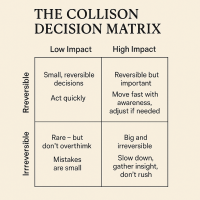 The Collison Decision Matrix Is A Practical Everyday Thinking Tool. Most of us spend a surprising amount of time worrying about decisions. From small ones such as what to wear, what to eat, what to te…
The Collison Decision Matrix Is A Practical Everyday Thinking Tool. Most of us spend a surprising amount of time worrying about decisions. From small ones such as what to wear, what to eat, what to te…The Power Of Asking The Right Question
 The Power Of Asking The Right Question Lies In The Quest For Insight. To experience the power of asking the right question you must develop the practice of asking questions. The best way to improve th…
The Power Of Asking The Right Question Lies In The Quest For Insight. To experience the power of asking the right question you must develop the practice of asking questions. The best way to improve th…Site Pathways
 Here is a site pathway to help new readers of Zen-Tools navigate the material on this site. Each pathway is based around one of the many key themes covered on this site and contain a 150 word introduc…
Here is a site pathway to help new readers of Zen-Tools navigate the material on this site. Each pathway is based around one of the many key themes covered on this site and contain a 150 word introduc…How To Live With Contradiction - Beyond Thought Let Stillness Speak
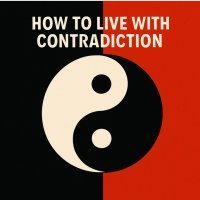 A major impact on so many peoples' lives is the situational contradiction of unfilled realistic expectations. So where does all this leave us? Well here we are, with mental equipment that is more lim…
A major impact on so many peoples' lives is the situational contradiction of unfilled realistic expectations. So where does all this leave us? Well here we are, with mental equipment that is more lim…How To Trust The Process Of Mindfulness - Right Now
 In mindfulness, the process isn’t some distant goal — it's what is happening right now. When we talk about how to trust the process of mindfulness the credibility of the process is heavily dependent…
In mindfulness, the process isn’t some distant goal — it's what is happening right now. When we talk about how to trust the process of mindfulness the credibility of the process is heavily dependent…Inner Mastery For Outer Impact - Mental Clarity For Effective Action
 Insights only matter if they translate into consistent action. In a world crowded with quick fixes and motivational soundbites, the theme “Inner Mastery for Outer Impact” calls us to something more e…
Insights only matter if they translate into consistent action. In a world crowded with quick fixes and motivational soundbites, the theme “Inner Mastery for Outer Impact” calls us to something more e…The Wise Advocate - Helping You Achieve The Very Best Outcome
 The focus of your attention in critical moments of choice either builds or restricts your capacity for achieving the best outcome. When we talk of 'The Wise Advocate' its easy to think of the consigl…
The focus of your attention in critical moments of choice either builds or restricts your capacity for achieving the best outcome. When we talk of 'The Wise Advocate' its easy to think of the consigl…Trust The Process - Beyond The Cliche
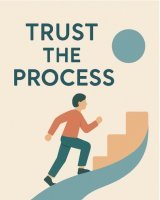 The phrase "trust the process" has become a cliche, the woo-woo mantra of the "self help" industry. Those three little words feel like they ought to mean something useful but hidden behind them are a…
The phrase "trust the process" has become a cliche, the woo-woo mantra of the "self help" industry. Those three little words feel like they ought to mean something useful but hidden behind them are a…The Dopamine Delusion - Why Anticipation Beats Achievement
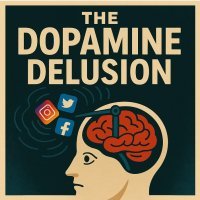 The thrill we feel is not in the having, but in the wanting. The more we have, the more we want. The more things we acquire and the easier things get for us, the more discontent we feel. The more spo…
The thrill we feel is not in the having, but in the wanting. The more we have, the more we want. The more things we acquire and the easier things get for us, the more discontent we feel. The more spo…The Power Of Silence Is Experienced In Your Use Of Language
 Practise the "Beneficial Neurological Delay" for optimal comprehension. The power of silence is experienced in your use of language, specifically: - How you formulate the words you use to think and in…
Practise the "Beneficial Neurological Delay" for optimal comprehension. The power of silence is experienced in your use of language, specifically: - How you formulate the words you use to think and in…Dealing With Setbacks - 5 Questions To Help You Face Discomfort
 How To Counter The Cognitive Shock Of A Setback. Setbacks challenge your instinctual desire for control and comfort, making it unnatural to respond with calm or acceptance. The reason for these instin…
How To Counter The Cognitive Shock Of A Setback. Setbacks challenge your instinctual desire for control and comfort, making it unnatural to respond with calm or acceptance. The reason for these instin…Why Praxis Is The Key To Living A Successful And Stress Free Life
 Praxis Is The Process Of Taking Informed Action To take informed action you need to be prepared with information, knowledge, education and insight. Informed action is objective action that: - Seeks to…
Praxis Is The Process Of Taking Informed Action To take informed action you need to be prepared with information, knowledge, education and insight. Informed action is objective action that: - Seeks to…
